One significant focus of the oil industry’s attention is the deep offshore. The offshore part of the world’s sedimentary basins – likely to contain source rocks for oil and gas – is estimated at around 50 million square kilometers. Two-thirds of this 50 area lies in Metres of water depths greater than 200 meters. This scope of increased deepwater drilling rig activities is considerable, and activity levels in these offshore environments are increasing.

Offshore Drilling Rig Categories
Each rig type is designed for a specific area and environment but can usually be used in other functions. Therefore, we must consider several factors when selecting a rig for a particular operation. Several options may appear acceptable for a given situation, but how do you select the best one? This part describes the operating capabilities and limitations of the various rig types to enable you to identify the most suitable unit for a given location.

The three basic types of offshore drilling rigs mentioned in the previous article (Drilling Rig Types) can be further sub-divided as listed below:


Bottom-Supported Offshore Drilling Rig:
- Submersibles
- Barge design
- Column design
- Jack-up rigs
- Mat supported
- Independent leg
- Slot type
- Cantilever type
- Platforms
- Steel jacket
- Gravity structure
- Compliant tower
- Tension leg platform
There are three types of bottom-supported drilling rigs:
- Submersibles: Mobile floating structures can be ballasted to sit on the bottom. Two types are available: barge design and column design.
- Jack-up rigs: Mobile units jack their legs down to the bottom and then elevate the hull from the water. Mat-supported and independent leg rigs are available as slot-type or cantilever-type units.
- Platforms: Structures piled into the sea bed, gravity set on the bottom or tension-legged. Steel jackets, gravity structures, compliant towers, and tension leg platforms differ.
Floating bottom-moored drilling units:
- Drilling tender
- Drilling barge
- Drillship
- Conventionally moored
- Turret moored
- Semi-submersible
Floating dynamically positioned drilling units:
- Drillship
- Semi-submersible
Submersibles Offshore Drilling Rigs
This category encompasses a group of mobile rigs ranging from drilling barges, which are sunk to the bottom in shallow water, to purpose-designed rigs resembling lightly constructed semi-submersibles, set on the bottom for the drilling operations. Both types supply the buoyancy required for a floating rig move, and operating water depth typically ranges from as little as 3 to 25 meters. Sitting on the bottom, they provide a fixed platform and thus experience minor ‘shutdown for the weather.’ The same drilling practices apply to jack-up rigs.
JACK-UP OFFSHORE DRILLING RIGS
Jack-ups are found worldwide and represent the largest group of offshore rigs. Using a jack-up in preference to a floating rig is usually advantageous whenever possible. The jack-up provides a stable drilling platform and will be less susceptible to shutdown during severe weather. Also, the operation itself is greatly simplified as the BOP stack is above water.
Operating water depth ranges from 3 meters for minimum draft shallow water units to 125 meters for the new generation ultra harsh environment units offering a drilling capability of 10,000 meters, maximum hook load of 2×106 lbs, and 15,000 psi BOP stack equipment. Jack-ups typically operate in the Gulf of Mexico, South East Asia and India, the North Sea, the Arabian Gulf, and West Africa. World Oil‘s Marine Drilling Rig ’95 Summary listed 387 rigs, which has remained relatively steady.
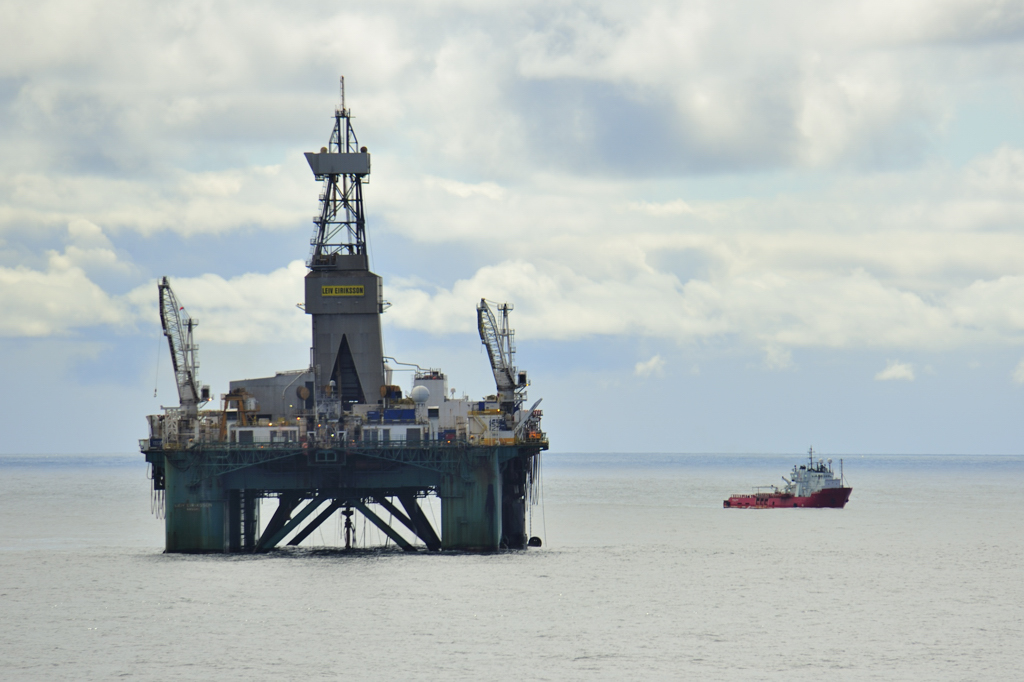
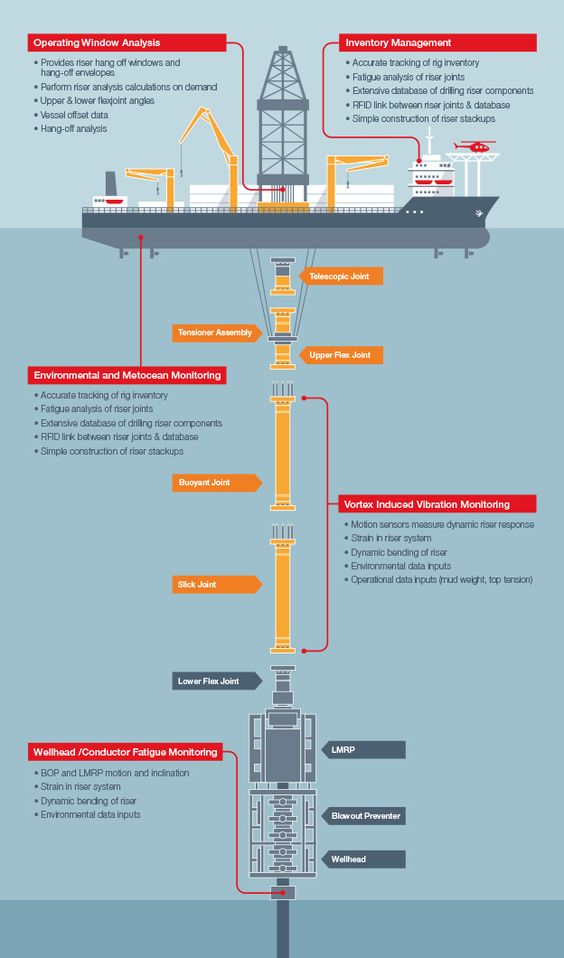
Platforms – Offshore Drilling Rigs
To drill an oil/gas well in the middle of the sea or ocean, we must have a platform to place the necessary drilling equipment and other accessories and ancillaries. Depending on whether the type of well is exploratory or development, the type of platform can be mobile or fixed. The term platform signifies some structure, and between these two major types of structures, there is one more category: the compliant type platform, which has its application.
Thus, depending on the number of wells to be drilled, the type of facilities to be installed on the topside, for example, oil rig, living quarters, helipad and so on, the depth of water, that is, shallow (<3 m), deep (350–1500 m), or ultradeep (>1500 m), practicality of methods of construction, fabrication and installation, meteorology and oceanography and finally the economics which vary globally from place to place, offshore platforms can be broadly categorized into three types:
- Fixed platform
- Compliant platform
- Mobile platform/units
Platform Costs & Timing
Although the platform installation costs may be high, the daily rig costs are lower than jack-up operations. Another advantage is the low frequency of weather downtime by these units. The deck has enough space for supplies during transport disruptions. Many platforms in the past had inadequate crane capacity, hampering drilling logistics..
Utilizing reliable platform rigs is to reduce significantly rigging-up and rig moving time. This means that drilling machinery is permanently installed in box frames that can be lifted as single units suitable for standing on the platform pile deck beams. The units, or packages, must be seized for the available crane barges. Building a rig this way allows a very compact arrangement of the rig components, permitting operation on a smaller minimum-cost platform. The risk of damage during moves is reduced. In addition, the part of the move operation most dependent on good weather conditions (lifting off and setting in place of the rig equipment) is short duration.
Read the full article about the Drilling Platform
Tender Assist Offshore Drilling Rig
One significant advantage of TADs is their suitability for standard platforms in water depths over jackup-rig rating. The design of these rigs allows it to accommodate the constraints of limited space and load limits often encountered in such platforms. By utilizing the TADs, operators can carry out drilling operations on these platforms without costly and time-consuming modifications.
Read full article about the drilling tender
Drilling Barge
As a drilling vessel, the drilling barge has fallen in popularity and is now only utilized for drilling in Lake Maracaibo in Venezuela (see Figure below). World Oil’s Marine Drilling Rig ’95 Summary lists approximately 36 units, with a depth rating ranging from 4,500 to 6,000 meters.
Drilling barges are barge-shaped floating drilling vessels with the derrick installed on a cantilever. They must be towed between locations and use a conventional eight-point cable mooring system. Poor motion characteristics and low freeboard limit their application to calm water locations in shallow water up to 50 meters.
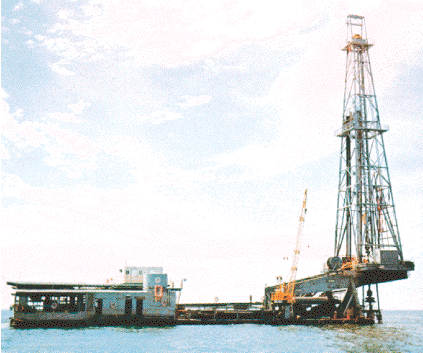
Drillship
The main advantages of a drillship (see Figure 5) over other mobile offshore drilling rigs are threefold:
- The speed at which the vessel can move between locations is up to 13 knots.
- The amount of equipment the vessel can carry on board while maintaining good stability, mainly due to the large hull storage capacity, is high.
- They are relatively cheap and easy to construct if we can convert a suitable ship.
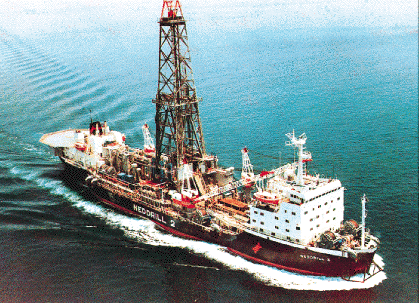
Due to the above-mentioned features, this type of vessel dominates the offshore exploration drilling market in remote locations. We can load the rig with enough equipment and supplies to drill two complete wells at a convenient supply base and sail quickly to its proposed drilling location. The lack of existing oilfield support facilities in a region with no or little history of drilling operations does not present a problem since the rig has all it requires on board. The only logistic support it requires is fresh food, personnel, and a standby safety vessel.
Anchored drillships fall into two generic types: conventionally moored and turret moored.
Conventionally Moored Drillships
Conventionally moored drillships typically have a fixed eight-point mooring system with four anchor winches at the bow and four at the stern. Most are cable moored, with 6-7 cm diameter cables being the norm.
The conventionally moored rig is the least suitable for drilling in rough and variable seas among the different drillships described in this section. These rigs are secured in a way that positions the bow toward the direction of the prevailing seas. As long as the seas continue coming from that direction, the vessel remains seaworthy and stable, just like the other drillships. However, if the prevailing seas shift by 90 degrees so that they hit the rig on its beam, the vessel’s motion undergoes a significant change.
Beam seas can cause excessive roll, and the derrick’s inertia during roll transmits high loads to the vessel’s hull at the points where the derrick substructure is mounted. There were cases of losing the rigs in heavy weather, resulting in the rupture of bulkheads at this point, allowing water to enter and ultimately sinking the rig. If beam seas exceed the rig’s design limits, releasing the anchor and driving off location should be considered.
Before selecting the mooring heading for the offshore drilling rig, meteorological data from the area must be studied to ensure that the rig will be pointing as much as possible into the prevailing seas. Conditions usually considered moderate can shut down the operations for waiting on weather if beam seas are encountered.
Note
Depending on sea conditions, these vessels can anchor in water as shallow as 50 meters and typically operate in water depths of 200 to 600 meters. World Oil’s Marine Drilling Rig ’95 Summary lists approximately 12 conventionally moored drillships, with a depth rating ranging from 4,500 to 6,000 meters.
Turret Moored Drillships
Only a few drillships, notably the Discoverer class from Sonat, are turret-moored type. This involves having a ring or turret mounted in the moon pool area of the vessel from which the rig is moored (see Figure 7.1.13). The vessel can rotate around this turret and maintain the optimum heading to minimize vessel movement in the prevailing seas.
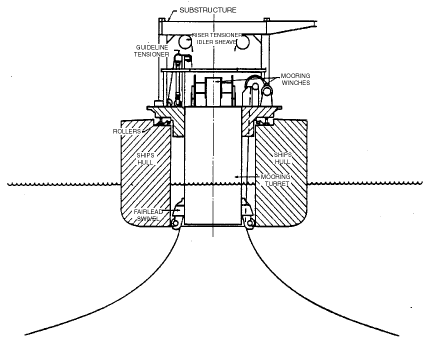
Turret mooring was introduced in the 1970s when Sonat designed the Discoverer series of vessels, but new builds have since then not included this feature. This is mainly due to the introduction of dynamic positioning systems. Turret-moored vessels can operate in water depths of up to 600 m. In addition, they can work for drilling depths ranging from 4,500 to 6,000 meters.
Semi-Submersible
The semi-submersible has evolved from early Gulf of Mexico submersibles to the point now where it dominates all harsh environment (deep) offshore exploration drilling. They operate with the buoyancy provided by those parts submerged beneath the water line, particularly the fixed pontoons, which sit 10 – 20 meters below sea level and are not influenced by wave action.
Large diameter buoyant columns at the corners and several smaller intermediate columns support the main deck. This gives the rig a transparent configuration so that waves roll through the structure and a relatively small area is exposed to wave action. As these units also have a much wider beam, their movement is much less than that experienced by ship-shaped vessels under similar sea conditions. Shut-down time for weather is, therefor,e generally lower than for drillships. However, achieving this stability was at the expense of mobility since moving speed is slower than for drillships.
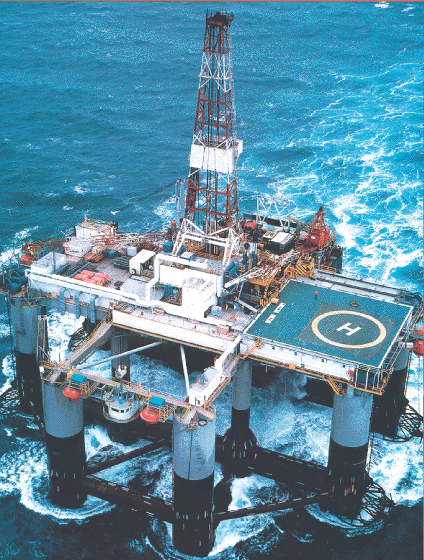
Water Depth
The minimum water depth limit for a semi-submersible offshore drilling rig is dependent on the prevailing environmental conditions. The limitations are imposed by the maximum rig heave and the lateral forces imposed by wind and sea conditions:
- Under no circumstances, we shall not allow the rig to ‘bounce’ on the sea bed or foul the BOP stack. The water depth must therefore be sufficient to ensure that these conditions will not occur during any combination of tide and weather conditions.
- In shallow water, we can experience unacceptable high anchor tensions by an anchored rig during periods of high waves, wind and current. This is due to the short catenary section of the anchor chain in shallow water which provides only a limited spring effect. This is, in part, a result of the positioning requirements of the rig, necessary to maintain the drilling riser angle within acceptable limits for drilling.
Moored semi-submersibles
The design of moored semi-submersibles allow the rigs to work for water depths ranging from 60 m to 600 m. We can normally accomplish the mooring with an eight, ten, or twelve-point mooring system consisting of chain, cable or a combination of chain and cable attached to the anchor. Moored semi-submersibles are the most common type on the market worldwide. A few dynamically positioned semi-submersibles are available for use in deep water. Their extra capital and operational cost restricts their use in relatively shallow continental shelf drilling operations. If a semi-submersible is fitted with thrusters for self-propulsion these can be used to assist the anchors in bad weather.
The First Generation
Semi-submersibles have developed into four generic groups, or generations. The first generation semi-submersibles were the old Gulf of Mexico submersibles that was suitable for floating use. Rigs such as the Sedco-135 series exemplify this type. They were usually not fitted with heave compensators, constant weight on bit (drill string weight calculations) being maintained with bumper subs, and riser tensioning achieved with balance weights or large buckets filled with iron.
The Second Generation
The second generation semi-submersibles began to appear in the mid 70s and are typified by the AKER-H3 design. These semi-submersibles had learned from the experience of the first generation semi-submersibles and had heave compensation, riser tensioners, larger deck loads and a self propulsion capability. At around the same time they moved towards a single BOP stack system instead of the twin stack system which had been popular in the early days. Typical variable deck loads for these rigs are 1,500-2,000 tonnes.
The Third Generation
The third generation semi-submersibles began to appear in the early 80s created by a need to move into deeper water and drill higher pressure wells. Typical third generation semi-submersibles such as the AKER-H4.2 designs are able to work in water depths of 100 – 600 metre and allow a variable deck load of 4,500 tonnes. Most third generation semi-submersibles come equipped with a single 183/4″ 10,000 psi BOP stack as standard. Gaining the extra deck load is usually by increasing the size of the columns connecting the deck of the rig with the underwater pontoons. As these columns get bigger however, their resistance to wind and waves increases, sometimes giving them inferior motion characteristics to the second generation types.
The Fourth Generation
The fourth generation semi-submersibles appeared in the early 90s again created by the need to move into deeper water or more hostile environments. These units are able to operate in water depths up to 1,300 metres, with a variable deck load up to 5,000 tonnes. BOP equipment rating is 15,000 psi as a standard. In addition, we can achieve a high degree of mechanisation for pipe handling operations. The upgrade for fourth generation rigs includes water depth enhancements, variable load improvements, new mooring systems and significantly improved drilling systems.